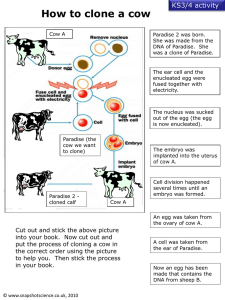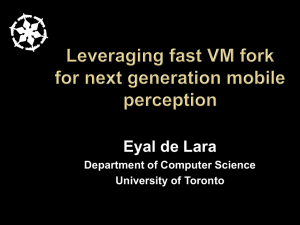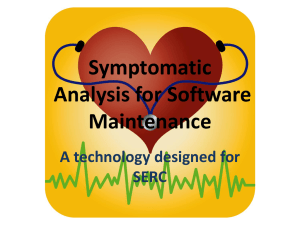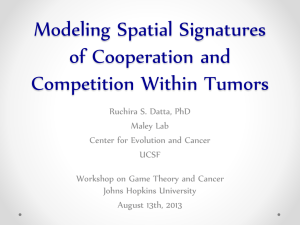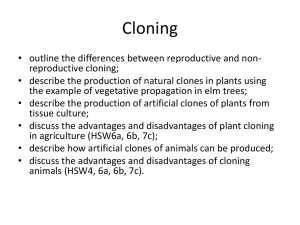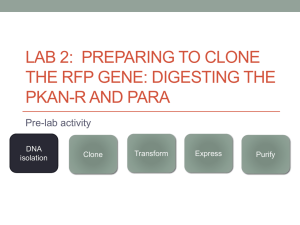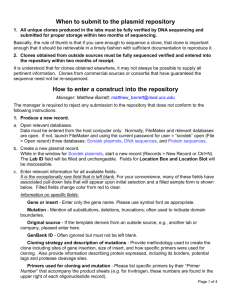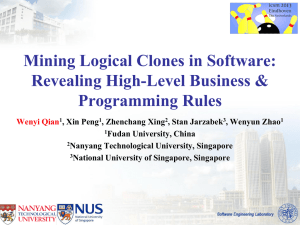Token based clone detection using program slicing
advertisement
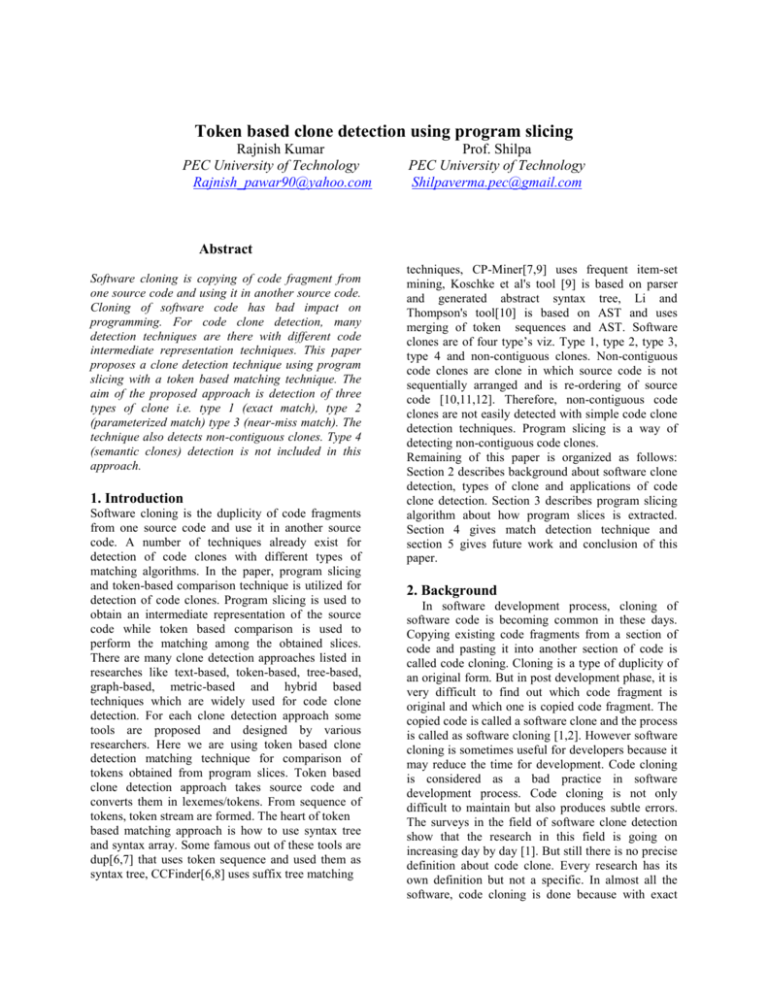
Token based clone detection using program slicing Rajnish Kumar PEC University of Technology Rajnish_pawar90@yahoo.com Prof. Shilpa PEC University of Technology Shilpaverma.pec@gmail.com Abstract Software cloning is copying of code fragment from one source code and using it in another source code. Cloning of software code has bad impact on programming. For code clone detection, many detection techniques are there with different code intermediate representation techniques. This paper proposes a clone detection technique using program slicing with a token based matching technique. The aim of the proposed approach is detection of three types of clone i.e. type 1 (exact match), type 2 (parameterized match) type 3 (near-miss match). The technique also detects non-contiguous clones. Type 4 (semantic clones) detection is not included in this approach. 1. Introduction Software cloning is the duplicity of code fragments from one source code and use it in another source code. A number of techniques already exist for detection of code clones with different types of matching algorithms. In the paper, program slicing and token-based comparison technique is utilized for detection of code clones. Program slicing is used to obtain an intermediate representation of the source code while token based comparison is used to perform the matching among the obtained slices. There are many clone detection approaches listed in researches like text-based, token-based, tree-based, graph-based, metric-based and hybrid based techniques which are widely used for code clone detection. For each clone detection approach some tools are proposed and designed by various researchers. Here we are using token based clone detection matching technique for comparison of tokens obtained from program slices. Token based clone detection approach takes source code and converts them in lexemes/tokens. From sequence of tokens, token stream are formed. The heart of token based matching approach is how to use syntax tree and syntax array. Some famous out of these tools are dup[6,7] that uses token sequence and used them as syntax tree, CCFinder[6,8] uses suffix tree matching techniques, CP-Miner[7,9] uses frequent item-set mining, Koschke et al's tool [9] is based on parser and generated abstract syntax tree, Li and Thompson's tool[10] is based on AST and uses merging of token sequences and AST. Software clones are of four type’s viz. Type 1, type 2, type 3, type 4 and non-contiguous clones. Non-contiguous code clones are clone in which source code is not sequentially arranged and is re-ordering of source code [10,11,12]. Therefore, non-contiguous code clones are not easily detected with simple code clone detection techniques. Program slicing is a way of detecting non-contiguous code clones. Remaining of this paper is organized as follows: Section 2 describes background about software clone detection, types of clone and applications of code clone detection. Section 3 describes program slicing algorithm about how program slices is extracted. Section 4 gives match detection technique and section 5 gives future work and conclusion of this paper. 2. Background In software development process, cloning of software code is becoming common in these days. Copying existing code fragments from a section of code and pasting it into another section of code is called code cloning. Cloning is a type of duplicity of an original form. But in post development phase, it is very difficult to find out which code fragment is original and which one is copied code fragment. The copied code is called a software clone and the process is called as software cloning [1,2]. However software cloning is sometimes useful for developers because it may reduce the time for development. Code cloning is considered as a bad practice in software development process. Code cloning is not only difficult to maintain but also produces subtle errors. The surveys in the field of software clone detection show that the research in this field is going on increasing day by day [1]. But still there is no precise definition about code clone. Every research has its own definition but not a specific. In almost all the software, code cloning is done because with exact clones: it shrinks 14% the size of code fragment and with parameterized clones: it shrinks 61% of the code clone [1,2]. About 20-30% of large software system consists of cloned code. Mostly code cloning happens due to open source software. In open source software, source code is provided; due to this any developer can easily use copy-paste and code cloning. With availability of source code, developers can easily cloning the functionality of code which is not textually similar. Software clones: According to different research studies, there are four basic types of clones. One study [1] shows that two types of similarities between two code fragments. Similarity of two code fragments is based on their similarity of program text and similarity of functionality. First three types are based on textual similarity and type four is based on functional similarity. The complexity of detecting software clones is going on increasing as we are going through from type 1 to type 4 clones. Type 1 (exact clones): Exact clones are similar code fragments but dissimilarity in white space and comments. Type 2 (renamed/parameterized clone): As the name suggests parameters are renamed in this type of clones i.e. identifiers (name of constants, variables, and functions), literals, types, layout and comments. Type 3 (near-miss clones): Code fragments with further modifications such as statements insertion/deletion and also changes to identifiers, types, layout, and literals. Type 4 (semantic clones): Code clones are the result of semantic similarity between two or more code fragments. These code clones are functionally similar but differ in textually.. 3. Finding Program slicing For program slicing various techniques are given by researchers [4,5]. These techniques use different methods for data flow and control flow [3,4]. In figure 1 a block diagram shows our complete process of clone detection using program slicing. The proposed clone detection approach consists of two phases, first phase is extracting program slices and second phase is an appropriate token based applied on the extracted slices. Here we are assuming program doesn’t have any dead code, i.e. every comment and non-functional statements are already removed from program. This is done by code optimization. Such process will increase the performance of program. Design can also incorporate such functionality. But here to simplifying the design we are not involving dead code removal section. Fig1: block diagram of process detecting software clones using program slicing 3.1 Steps for program slicing: Find all Global and main program variables Find program sections ( conditional statements , Loops, functions etc) Find slice of every section based on local, global and main program variables. (Tag every slice base on variable present inside the slice) Find slice of main program without including sections. (Tag every slice base on variable present inside the slice) Union main program slices with section slices based on Tag. Statements tag to corresponding variable gives one slice and so on. Firstly, source code is taken as input and all variable used in program are stored in a variable list. After this, program sections are found out by scanning the whole program, program sections i.e. conditional statements, loops and function and store them in a table. Then, step 3 and step 4 gives program slices with respect to control flow and data flow sequence. For step 3, Section can be tagged by making list with section name and starting and ending line in code. The list which is generated from above execution will have starting and ending line of every section. By using this list we can find the slice from that section only with boundary of starting and ending line. The lines of source code belonging to this section may also contain section as found in previous step. So there is need to check every section for tracing subsection. To do so, before proceeding further, we will repeat step similar to Step 2, 3, 4 and 5 until we reach to bottom of the source code tree. For dependency check, a variable is chosen from variable list and a check is made for program section i.e. for functions, loops. If match is found i.e. whole section is dependent on that variable, then that section is included to tag statements. Again section is checked for subsections and further inside each section, statements are checked for dependency of that variable. If match is found then statements for which variable dependency is present, merged to tag statement list. Tag statement list is a list which stores statements dependent corresponding to particular variable. Finding slice from conditional statements: Conditional statements are dependent on some variable. Generally every programming language contains conditional statements like “IF ELSE” and “SWITCH”. Variable on which any conditional statement is dependent, then every statement of this section will be dependent on that variable. So, every line which are part of this section will be part of this variable i.e. every inside statement will be under the tag of this variable. Further underlying slices can also be found which will be tag on local and parent variables. Parent variable are variable for where current section is called. Output: Program slice Tagged by Variable, these tags will be used to union the section with parent section. Finding slice from Loops: Loops are used to repeat some statement again and again. Loop statements are dependent on some variable. Variable on which loop statements are depended every statement of this section will be dependent on that variable. So, every line which are part of this section will be part of this variable i.e. every inside statement will be under the tag of this variable. Further underlying slices can also be found which will be tag on local and parent variables. Output: Program slice Tagged by Variable, these tags will be used to union the section with parent section. Finding slice from functions: Functions are used inside the program to avoid repetition of code statements and to simplify to development process. Functions increase reusability of codes. As conditional statements and loop statements, function can also dependent on some variable. Variable on which function statements are depended every statement of this section will be dependent on that variable. So, every line which are part of this section will be part of this variable i.e. every inside statement will be under the tag of this variable. Further underlying slices can also be found which will be tag on local and parent variables. Output: Program slice Tagged by Variable, these tags will be used to union the section with parent section. Find slice of main program without including sections. (Tag every slice base on variable present inside the slice). All effective statements of code are dependent on some variable. An operation on the variable affects the state or value of some variable. Change in the variable can depends on the other variable. To find on which variable particular statement of source code is dependent on we need to find the variable which affect current statement. Statements of code which are before current statement, all the line which are affects the dependent variable will be include inside the current variable slice. Finally this will let to the line on which a variable dependent on with the list of dependent variable. 3.2 Algorithm for program slicing: Our algorithm for program slicing is based on some designed rules for variables and expression used in program code. a) Effective statements are assignment statements. The assignment statements have the following form, Variable = expression; Its purpose is saving the result of the expression to the right of the assignment operator to the variable on the left. The value is changed of the variable by expression and this changed value of variable is affected by expression. b) Effective statements only affect the behavior. The behavior of the program is affected by only effective statements. As explained above effective statements involve change in value of variable and it is used further in whole program. Some program section depends on this variable so it changes the behavior of program. c) Effective statement affects single variable at a time. Effective statement involves an expression and it writes value of expression on single variable on left side so it affects single variable at a time. d) Effected variable can be affected by zero or more other variables. v1 = v1 + 1; //statement 1 v1 = v2 + v3; //statement 2 In statement 1 variable v1 is not affected by any variable because it involves only itself in But in statement 2 variable v2 is 3.2.1.expression. Rule based slicing: affected by variables v2 and v3. e) Indirectly all statement above that statement belongs to effecting variable. Our intention of finding slicing is to detect software clones. Slices are done in a way to find independent sections of program. Slice is the independent part of program which is not affected by rest of program. Here slicing is done with finding variable dependency because variables affects the behavior of program. Therefore, some rules are derived for finding slicing. And these rules are quite obvious for person in field of software designing or development. Derived rules for slicing: 3.2.2. Algorithm for program slicing: 1) Scan the program file and store each statement in a list (stmt_list). 2) Scan the program file line by line and find all variables to store all variables in a list (variable_list). 3) Scan the whole program for finding program sections i.e methods, loops, conditional statements sections store the each section in a table with start and end line of program sections separately. 4) Make a slice for each section. a) Take a variable from variable_list and check for each section in section table i) if(section is dependent on this variable) ii) then include the section into the new table corresponding to the variable and delete entry from section table. iii) Else if (check for variable in program section body) iv) if(match found) then v) add statement corresponding to that variable and select entry from section table. vi) Else if (check for subsection) 5) do repeat whole step 4. 6) make a slice for main program i) take a variable from variable list and check in stmt list ii) if (variable is present) then add this statement to list corresponding to that variable and remove statement from stmt_list iii) else variable does not depend on the statement 7) merge statements coming from step 4 and step 6 for same variable and extract statements for corresponding to single variable gives one slice and so on. textual comparison renaming of variables does not appears as similar match and results in the conflict of matching. So, we are using appropriate token based comparison technique. Tokens are smallest individual unit of a program. In token based comparison technique tokens are extracted from lexical analysis or transformation of complete source program. But we are using tokenization of program slices only because we are comparing program slices only. Therefore, it results in less time as compared to complete source program transformation to lexical analysis. In our tokenization process, we are tokenizing variables of program slices into tokens and then slices with tokens of variables are compared. If match is found it results in software clones as according number of statements match of program slices and gives percentage and type of clones. 5. Conclusion and future work: In this paper, a new approach is proposed for program slicing that is used for software clone detection. Program slices are extracted with use of variable dependency. The variable dependencies have been represented in the form of matrix.The approach attempts to utilize the variable dependency from variable relation adjacency matrix to find out program slices. The program slices are then converted to tokens and token based comparison is done for detecting of clones. Finally it gives software clone in form of clone percentage and type of clones. This methodology for detecting software clone using program slicing is executed for structured programming; however, it can be extended for object-oriented programs for future work. Our methodology works on source code and detects software clones, for future it can be used as detection of malware code by checking it with machine codes. 6. References: 1. 2. 3. 4. Match detection technique: As described above program slices are extracted in first phase of process software clone detection. In second phase of process of detecting clones a match detection technique must be used for comparison. In 4. 5. C.K. Roy, J.R. Cordy, A Survey on Software Clone Detection Research, Technical Report 2007-541, Queen’s University at Kingston Ontario, Canada, 2007, p. 115. Dhavlesh Rattan, Rajesh Bhatia, Maninder Singh, Software Clone Detection: A Systematic Review, Information and Software Technology 55 (2013) 1165-1199. J.-F. Bergeretti and B.A. Carr´e. Informationflow and data-flow analysis of while-programs. ACM transactions on Programming Languages and Systems, 7(1):37–61, 1985. A Survey of Program Slicing Techniques by Frank Tip. Weiser, Mark. “Program Slicing.” Proc. 5th Intl. Conference on Software Engineering, San Diego, California, IEEE Computer Society, March 1981, 439-449. 6. B. Baker, On finding duplication and nearduplication in large software systems, in: Proceedings of the 2nd working Conference on Reverse Engineering (WCRE’95), Toronto, Ontario, Canada, 1995, pp. 86–95. 7. S. Bellon, R. Koschke, G. Antoniol, J. Krinke, E. Merlo, Comparison and evaluation of clone detection tools, IEEE Transactions on Software Engineering 33 (9) (2007) 577–591. 8. T. Kamiya, S. Kusumoto, K. Inoue, CCFinder: a multi-linguistic token-based code clone detection system for large scale source code, IEEE Transactions on Software Engineering 28 (7) (2002) 654–670. 9. Z. Li, S. Lu, S. Myagmar, Y. Zhou, CP-Miner: finding copy–paste and related bugs in largescale software code, IEEE Transactions on Software Engineering 32 (3) (2006) 176–192 10. R. Koschke, R. Falke, P. Frenzel, Clone detection using abstract syntax suffix trees, in: Proceedings of the 13th Working Conference on Reverse Engineering (WCRE’06), Benevento, Italy, 2006, pp. 253–262. 11. Y. Higo, S. Kusumoto, Code clone detection on specialized PDG’s with heuristics, in: Proceedings of the 15th European Conference on Software Maintenance and Reengineering (CSMR’11), Oldenburg, Germany, 2011, pp. 75– 84. 12. R. Komondoor, S. Horwitz, Using slicing to identify duplication in source code, in: Proceedings of the 8th International Symposium on Static Analysis (SAS’01), vol. LNCS 2126, Paris, France
